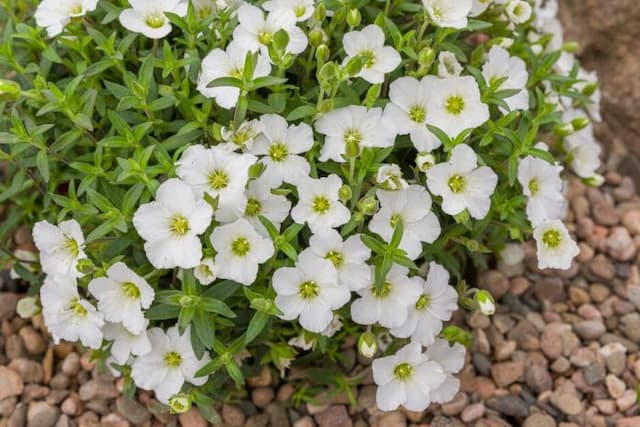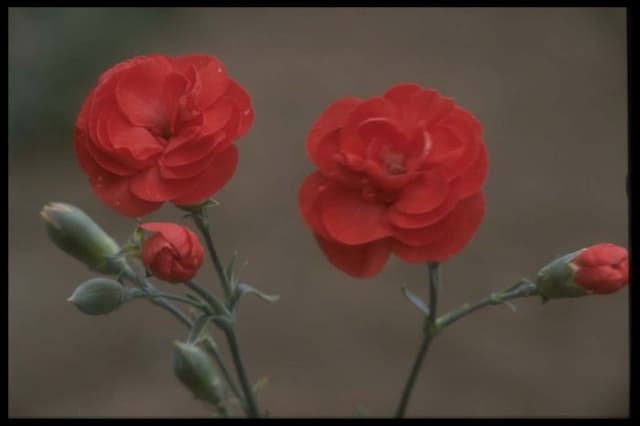Baby's breath Psammophiliella muralis 'Gypsy Deep Rose'

ABOUT
Psammophiliella muralis 'Gypsy Deep Rose', commonly known as wallflower, is a visually captivating plant known for its lush floral display. This variety is distinguished by its striking deep rose-colored flowers that add a vibrant pop of color to any garden setting. The blossoms are typically small, with a clustered look that creates a full, dense effect. Each flower exhibits four petals arranged in a cross-like pattern, a characteristic feature of wallflowers. The foliage of the Gypsy Deep Rose is also noteworthy; it is comprised of narrow leaves that are typically bright green, providing a lush backdrop for the intense rose-colored blooms. The leaves are moderately long, emanating from the base of the plant in a form that could be described as a basal rosette. This organized arrangement of leaves at the base adds a pleasing, structured feel to the plant's overall appearance. Wallflowers are especially favored for their extended blooming period. They tend to blossom in generous flushes that cover the plant in a tapestry of rich color. This variety, with its deep rose hue, offers a sophisticated alternative to the more commonly seen golden or yellow wallflowers. Their notable flowering capacity make Gypsy Deep Rose an ideal choice for gardeners looking to create an impact through color. Despite the absence of any mention of specific dimensions, the vivid beauty of Psammophiliella muralis 'Gypsy Deep Rose' makes it a standout selection in gardens or as part of cut flower arrangements, where its floriferous nature and captivating color can be showcased.
About this plant
 Names
NamesSynonyms
Gypsy Deep Rose Sandwort, Deep Rose Stonecrop
Common names
Psammophiliella muralis 'Gypsy Deep Rose'.
 Toxicity
ToxicityTo humans
Information on Psammophiliella muralis 'Gypsy Deep Rose' is not readily available. Without specific scientific research or data on this particular cultivar, it's not possible to provide accurate information on its toxicity to humans. If this is an ornamental plant, as many are, a general precaution would be to avoid ingesting it, as the toxicity of ornamental plants can vary widely. Without certainty, it's always safer to assume an unknown plant might be harmful if ingested. If poisoning is suspected, seek medical attention promptly.
To pets
There is no specific information on the toxicity of Psammophiliella muralis 'Gypsy Deep Rose' to pets. As with humans, without targeted research or reports, the toxicity of this specific cultivar to pets is unknown. Many plants can be toxic to pets, with symptoms ranging from mild gastrointestinal upset to more severe conditions like organ failure or neurological issues, depending on the plant's toxins. It's generally wise to prevent pets from ingesting unknown plants and to consult a veterinarian if any part of an unknown plant is consumed.
 Characteristics
CharacteristicsLife cycle
Perennials
Foliage type
Deciduous
Color of leaves
Green
Flower color
Deep Rose
Height
1-2 feet (0.3-0.6 meters)
Spread
1-2 feet (0.3-0.6 meters)
Plant type
Herb
Hardiness zones
Varies
Native area
Varies
Benefits
 General Benefits
General Benefits- Aesthetic Value: Adds vibrant color with its deep rose flowers to gardens and landscapes.
- Low Maintenance: Requires minimal care once established, making it suitable for busy gardeners.
- Drought Tolerance: Can withstand periods of low water availability, ideal for xeriscaping or dry climates.
- Pollinator Attraction: Attracts bees, butterflies, and other pollinators, supporting local ecosystems.
- Fast Growth: Has the ability to grow quickly, filling in garden spaces in a short amount of time.
- Versatility: Adapts to a variety of soil types and conditions, providing flexibility in garden design.
- Seasonal Interest: Provides seasonal blooms that can enhance the garden's visual interest throughout the growing season.
- Ground Coverage: Can act as ground cover, reducing soil erosion and suppressing weed growth.
- Compact Size: Suitable for small spaces, containers, or borders due to its compact nature.
- Deer Resistance: Less appealing to deer, which can help prevent damage to the garden.
 Medical Properties
Medical PropertiesThis plant is not used for medical purposes.
 Air-purifying Qualities
Air-purifying QualitiesThis plant is not specifically known for air purifying qualities.
 Other Uses
Other Uses- The flowers of 'Gypsy Deep Rose' can be used to create natural dyes for fabrics, offering a range of pink hues depending on the mordant used.
- The plant can be implemented into a sensory garden, providing textures and colors that stimulate the senses and support cognitive development.
- 'Gypsy Deep Rose' can be utilized in educational gardens to teach about ecological concepts such as sand dune stabilization and xeriscaping.
- Because of its hardiness, it can be used in erosion control projects in coastal areas where stabilization of sandy soils is required.
- This plant is perfect for creating low-maintenance container gardens that can add color to urban spaces like balconies and rooftops.
- Craft enthusiasts might use the dried flowers of 'Gypsy Deep Rose' in potpourri mixes for a natural and delicate scent.
- The plant's distinct color makes it a valuable addition to butterfly gardens, attracting pollinators and adding to biodiversity.
- It can be used as a living mulch in dry landscapes, suppressing weeds while retaining soil moisture and adding aesthetic value.
- 'Gypsy Deep Rose' serves as a groundcover to outline pathways or borders within garden designs, enhancing the visual experience.
- Creative gardeners could use the plant's structure to create intricate garden patterns or mosaics when viewed from above.
Interesting Facts
 Feng Shui
Feng ShuiThe Wallflower ('Erysimum' or 'Cheiranthus') is not typically used in Feng Shui practice.
 Zodiac Sign Compitability
Zodiac Sign CompitabilityThe Wallflower is not used in astrology practice.
 Plant Symbolism
Plant Symbolism- Love and Affection: The rich, deep rose color of the Gypsy Deep Rose plant is often associated with deep emotion and a strong expression of love, similar to the symbolism carried by the color of red roses.
- Enchantment: The Gypsy Deep Rose carries a sense of mystique and fascination, possibly due to its unique appearance, which might evoke feelings of being enchanted or charmed by its beauty.
- Survival and Resilience: As a plant that thrives in tough conditions, it can symbolize the ability to endure and adapt, mirroring resilience in the face of adversity.
 Water
WaterThe Gypsy Deep Rose, commonly known as a type of Wallflower, requires moderate watering. Ensure the soil is moist but not waterlogged, watering thoroughly when the top inch of soil feels dry to the touch, which typically occurs once a week. During the active growing season in spring and summer, you might need to water more frequently. It is best to use approximately one gallon of water every two weeks, adjusting as necessary for your climate and the plant's response. During the dormant winter months, reduce watering to prevent root rot due to excess moisture.
 Light
LightThe Gypsy Deep Rose Wallflower thrives in full sun to partial shade. The ideal lighting condition is a spot that receives at least four to six hours of direct sunlight each day. If the plant is grown indoors, place it near a south-facing window where it can get plentiful light but is protected from the intense midday sun.
 Temperature
TemperatureThe Gypsy Deep Rose Wallflower prefers a temperate climate with temperatures ranging from 55°F to 75°F. It can endure minimum temperatures of 40°F, making it suitable for growth in cooler climates provided it is protected from frost. It is important to avoid exposure to temperatures below 40°F and above 80°F to maintain the plant's health.
 Pruning
PruningThe Gypsy Deep Rose Wallflower should be pruned to encourage bushier growth and more blooms. Prune in early spring as new growth appears, cutting back any dead or leggy stems. Deadheading, or removing spent flowers, will promote continuous blooming. Pruning can be done every few weeks during the blooming period to keep the plant tidy and encourage further flowering.
 Cleaning
CleaningAs needed
 Soil
SoilThe ideal soil mix for Lychnis (common name) should be well-draining with a mixture of loam, peat, and sharp sand to mimic its natural habitat. The soil pH should be slightly alkaline, ranging from 7.0 to 7.5.
 Repotting
RepottingLychnis should be repotted every 2 to 3 years to refresh the soil and accommodate root growth. This timing helps to maintain nutrient availability and prevent over-crowding of the roots.
 Humidity & Misting
Humidity & MistingLychnis prefers moderate humidity levels, though it can tolerate a range of conditions. Aim to maintain humidity around 40-50% for optimal growth.
 Suitable locations
Suitable locationsIndoor
Place in bright indirect light, on well-draining soil.
Outdoor
Plant in full sun to partial shade, well-draining soil.
Hardiness zone
5-9 USDA
 Life cycle
Life cyclePsammophiliella muralis 'Gypsy Deep Rose', commonly known as Gypsy Deep Rose wallflower, begins its life as a seed, which when sown, will typically germinate within a couple of weeks given the right conditions of warmth and moisture. After germination, it enters a vegetative stage where seedlings establish themselves and grow into mature plants through the vegetative growth of foliage. As the plant matures, it develops flowering stems which set buds that open into colorful rosy-purple blooms, attracting pollinators to its nectar-rich flowers. After the flowering phase, which can continue through various flushes of blooms in its biennial cycle, the plant sets seed, completing its reproductive stage. The seeds are then dispersed by wind or animals, allowing the plant to propagate in new locations where the cycle begins anew. In colder climates, the plant may die back in winter, but it can produce offspring that will continue its lineage in the following growing season.
 Propogation
PropogationPropogation time
Spring-Early Summer
Psammophiliella muralis 'Gypsy Deep Rose', commonly known as the “Wallflower,” is most effectively propagated through the method of seed sowing. The best time for sowing Wallflower seeds is in late spring or early summer, after the last frost has passed, ensuring a warm soil temperature that is conducive to germination. To propagate, one would scatter the seeds lightly onto well-draining soil and press them gently into the surface, as Wallflower seeds require light to germinate, and then mist lightly with water to moisten the soil without causing the seeds to wash away. Seedlings will typically emerge in two to three weeks, at which point they can slowly be acclimatized to outdoor conditions if started indoors. Once seedlings have grown large enough to handle, they can be transplanted to their final growing location, spacing them about 8 inches (20 centimeters) apart to accommodate their mature size.


![Pink [Tequila Sunrise]](/_next/image?url=https%3A%2F%2Fplants-admin.emdemapps.com%2Fimages%2Fplants%2F%2Fimages%2F604b5d995d06e.png&w=640&q=75)






